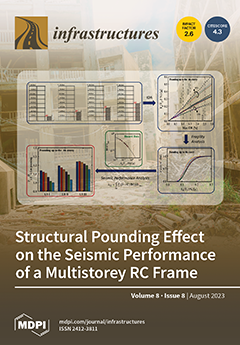This work presents a discussion of the basic properties of broken mineral limestone aggregates with the specification of the properties affecting the fracture toughness of concretes made with these aggregates. To determine the influence of the grain-size distribution of coarse aggregates for each concrete series, two types of aggregate grain were used, with maximum grain sizes of 8 mm (series of concrete L1) and 16 mm (series of concrete L2). Fracture-toughness tests were carried out using mode I fractures in accordance with the RILEM Draft recommendations, TC-89 FMT. During the experiments the critical stress-intensity factor
and crack-tip-opening displacements (
) were determined. The main mechanical parameters, i.e., the compressive strength (
fcm) and splitting tensile strength (
fctm), were also assessed. Based on the obtained results, it was found that the grain-size distribution of the limestone aggregate influenced the concrete’s mechanical and fracture-mechanics parameters. The obtained results showed that the series-L2 concrete had higher strength and fracture-mechanics parameters, i.e.,:
fcm—45.06 MPa,
fctm—3.03 MPa,
—1.22 MN/m
3/2, and
—12.87 m10
−6. However, the concrete with a maximum grain size of 8 mm (series of concrete L1) presented lower values for all the analyzed parameters, i.e.,:
fcm—39.17 MPa,
fctm—2.57 MPa,
—0.99 MN/m
3/2, and
—10.02 m10
−6. The main reason for the lower fracture toughness of the concretes with smaller grain sizes was the weakness of the ITZ in this composite compared to the ITZ in the concrete with a maximum grain size of 16 mm. The obtained test results can help designers, concrete producers, and contractors working with concrete structures to ensure the more conscious composition of concrete mixes with limestone aggregates, as well as to produce precise forecasts for the operational properties of concrete composites containing fillers obtained from carbonate rocks.
Full article





